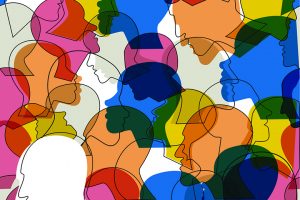
Diversity is prevalent in our society and offers a unique perspective on humanity. While diversity and multicultural presence have many positive effects on humankind, it also provides a learning tool to personal adverse experiences. In this sense, social workers must take into account the historical encounters that make up the individual. I will remain a curious learner to absorb knowledge when possible about various cultures. I will also refer to research and evidence-based practices to help navigate relationships with clients that share a different culture than my own. Attending ongoing diversity training will be a professional priority. Most importantly, I will regularly self-assess my own biases in a diverse helping relationship.
2.1: Develop and implement strategies that strive to eradicate discrimination in any form.
Course Evidence: For a group project in my Advanced Administration Practice: Program Development course, I collaborated with colleagues to create a needs assessment and program proposal. The Community Connect Project with Chattanooga Police Department proposed to implement culturally-informed policing approaches and annual diversity training after identifying racial inequalities in police violence in the Chattanooga community. The program aims at promoting partnership between the police and the diverse community it serves, while also emphasizing transparency and accountability within the police department. This project included a thorough examination of the needs of the community and research of historical discriminatory policing activities. Various evidence-based interventions were used to understand successful changes that could improve a possible union among the Chattanooga police and all citizens and decrease injustice that is prevalent in the system.
Field Evidence: I had the opportunity to attend the Family Focused Treatment Association (FFTA) 34th Annual Conference in 2020. The conference was appropriately titled “Bringing Resiliency Home” to reflect the social climate of 2020. I attended various classes that promoted diversity and cultural competency in the foster care field. One particular class, Racial Disproportionality and Inequity in Child Welfare discussed the disproportioned number of Child Protective Service (CPS) reports and foster care admission of minority populations. Other key issues covered at the conference included adverse experiences often present for rural populations, women, and LGBTQ+ populations. Evidence-based interventions, proper assessments, policies, and further research is crucial to continue the work to alleviate discrimination towards these populations.
Additional Evidence: The New Normal: LGBTQ+ Youth Living Through COVID 19 symposium provided me a more diverse outlook on LGBTQ+ foster youth dealing with re-traumatization when experiencing discrimination and prejudice regularly in foster homes. After attending the symposium, I learned how intake assessments and gathering placement preference details from the children could improve each youth’s foster care journey. The symposium heavily relied on the intersectional feminist theory when discussing the inequality of gender, power, and sexuality and how to improve the lives of these youth during and after their foster care experience. I shared this knowledge with Omni Visions to consider including additional components during the agency’s intake process. The agency has also considered ways to improve their foster parent training curriculum to help enlighten foster parents and minimize this type of discrimination.
2.2: Implement evidence-based and culturally-informed strategies with diverse populations.
Course Evidence: I studied culturally effective helping techniques for crisis intervention during my Trauma Foundation course. While there are varying ways to best approach different types of cultural norms and customs, this class discussed effective approaches to implement when working with individualists and collectivists. I learned the difference between high-context and low-context culture identity. I wrote a Discussion Post to use this knowledge to show approaches that could best promote engagement, rapport, assessment, and intervention with these types of cultures in times of crisis and emergency management.
Field Evidence: I learned how to use the DSM 5 Cultural Formulation Interview with therapy clients. This evidence-based tool allowed me to gather culturally relevant information from clients during diagnostic intake assessments and individual therapy sessions. It allowed me to better understand values and influence derived from cultural connections. I found this particularly important when working with clients from a different culture than my own to understand and support them properly in the helping relationship.
Additional Evidence: I completed training on The Indian Child Welfare Act and followed the requirements mandated for caseworkers in foster care while working with a Native American foster child. I actively worked with the child and family team to locate the biological family and involve the child’s tribe.